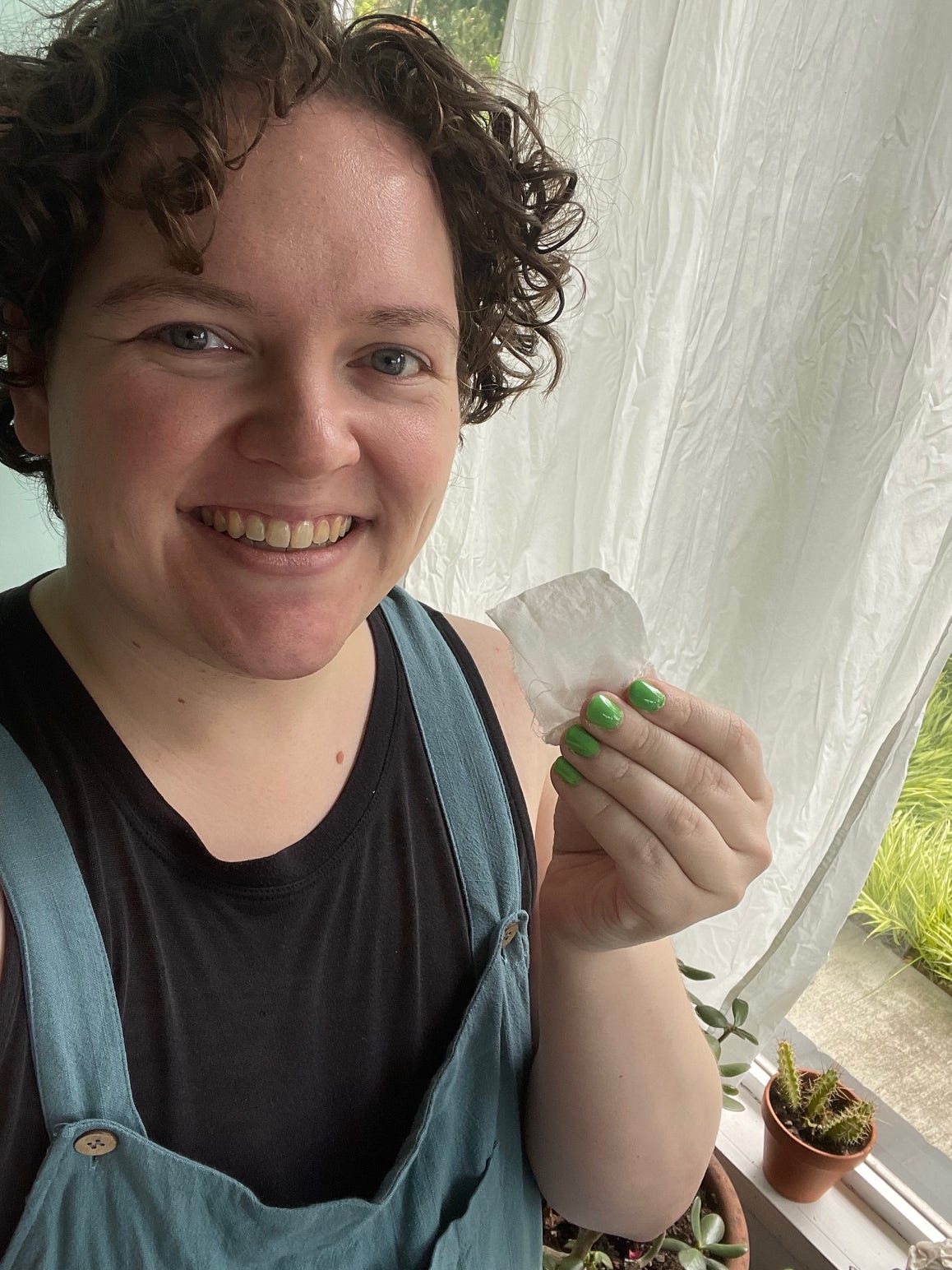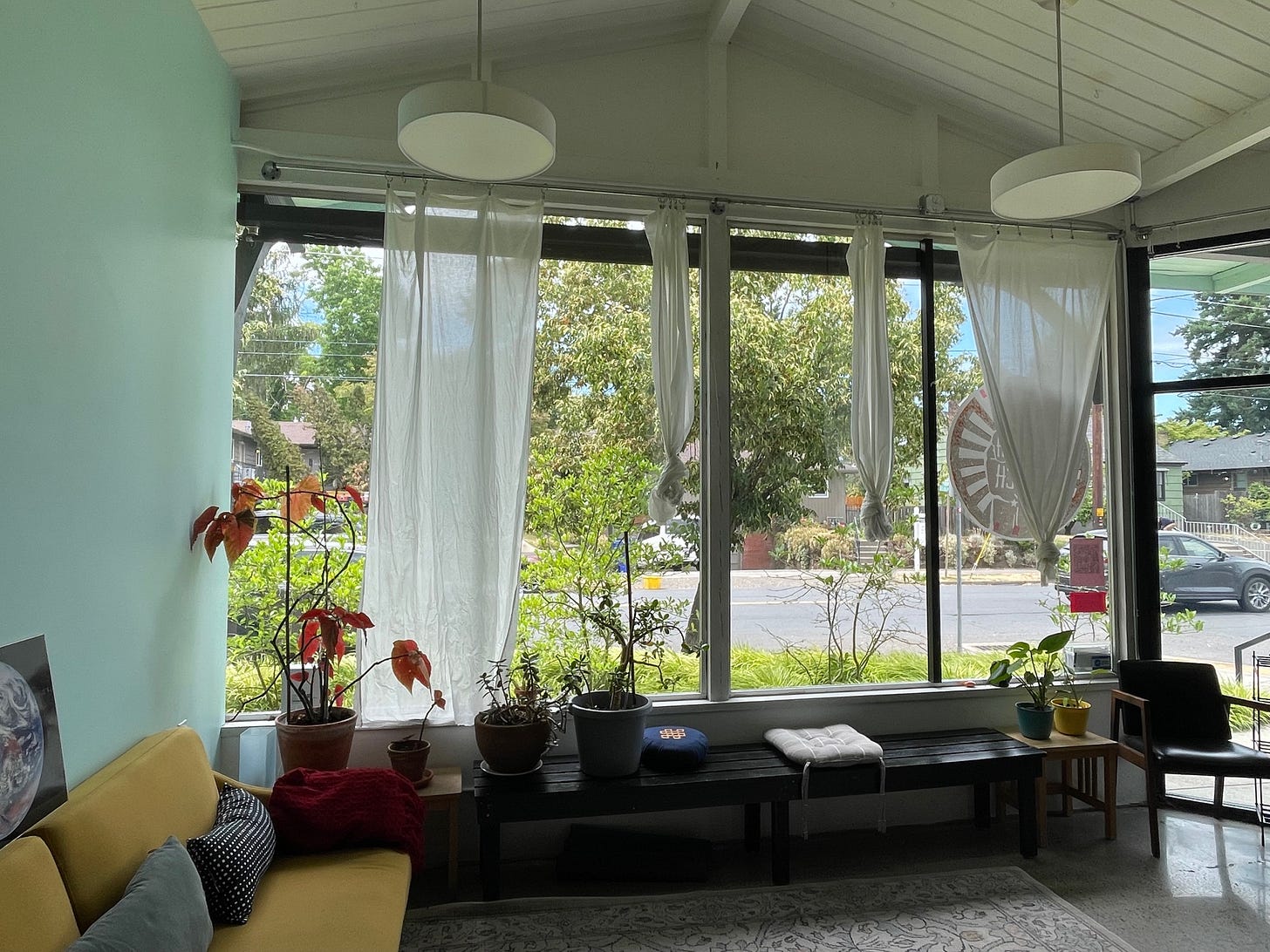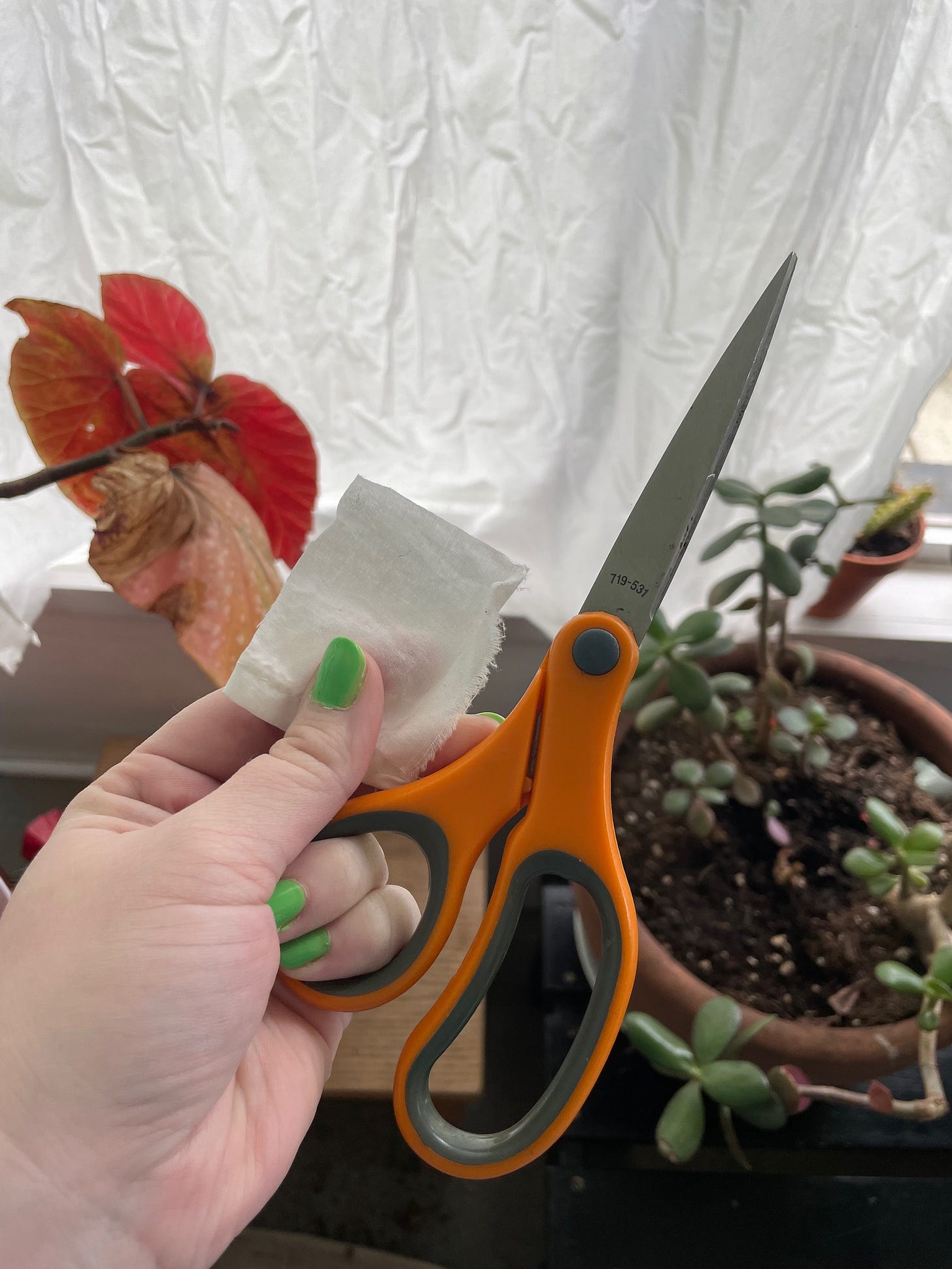This is a video of POCA Tech’s Registrar, Noni, setting a piece of our classroom curtains on fire. There’s a good reason, I promise — it was part of our annual fire inspection — and also there’s a good reason for me sending you this video, which I’ll get to in a minute. (Video and photos courtesy of Noni.)
Fire inspections are required by the state agency that licenses our school, which is entertainingly named HECC (aka the Oregon Higher Education Coordinating Commission). And let me tell you, fire inspections for POCA Tech have been a whole thing.
Up until a year ago, our classroom was always in a shared space which meant that we couldn’t initiate our own fire inspections, we had to coordinate them with our hosts. That didn’t always work. Back in 2018, we got tangled up in a situation where our host couldn’t seem to schedule a fire inspection; for reasons we never understood, the fire marshal wouldn’t return their calls and as a result, we were almost out of compliance with both our state licensing agency (HECC) and our national accreditor (ACAHM). This happened just a few months after another snafu, in which HECC was late in issuing us a hard copy of our license and ACAHM got cranky about it, resulting in many frantic phone calls and emails — so the fire inspection and its attendant paper trail turned into a high-stakes, stressful event.
What I’m trying to say is that Noni setting the curtains on fire, in our own space, represents a big improvement and a decrease in drama.1
There were a lot of things I had to learn in order for us to have our own acupuncture school. One of the biggest was how much my relationship to bureaucracy, regulations and regulators had to change.
It’s probably a class thing to be terrified of bureaucracy, but it doesn’t particularly help to know that it’s a class thing. For example (continuing with our theme of student loans) I was a first generation college student and as an undergraduate, visiting the financial aid office was a particular kind of hell — because my parents kept filling out the forms wrong. My tuition was often late and I was constantly worried I’d get kicked out.
Once I was doing an intake with a new patient at WCA and she said, “I’m sorry, filling out these forms is really hard for me because it triggers my PTSD” — and she went on to explain that she and her daughter used to be houseless and whenever she tried to access any kind of help, she was afraid that her daughter was going to be taken away from her. It had almost happened, more than once. Eventually she got an apartment and her daughter was now in college and doing well, but she couldn’t get over her fear of forms. “I understand,” I said to her.
So learning how to tolerate the mind-boggling amount of paperwork involved in setting up an acupuncture school — from the fire inspections on one end to the accreditation self-studies on the other, including all the internal forms and processes we had to create ourselves just to have a functional administration for POCA Tech — was weirdly redemptive for me. Because there are a lot of things you can’t do — and things you can’t make — in the world without a certain amount of bureaucracy. These days, if a regulator tells us we need to set the curtains on fire, I feel good about setting the curtains on fire. I recognize it as part of the creative process.
This is all by way of introducing the next phase in the 5NP process for Oregon, and to say that I know it will freak some people out. I get it. But first, let’s rewind for anyone who hasn’t been following our 5NP process (hi, new subscribers!):
Back in the summer of 2022, Cohort 8 students at POCA Tech who were learning about the history of 5NP said, “But why doesn’t Oregon have a 5NP law? That doesn’t make any sense” and I said, “I agree it doesn’t make sense, but someone would have to work pretty hard to change that. How about you? Are you up for it?” They were.
5NP is used in communities all over the world; in Oregon, the practice of 5NP is led by indigenous people. Thanks to our organizational partnership with the Native American Youth and Family Center — which had recently established its legislative arm in the form of the NAYA Action Fund — we had expert guidance and help with the legislative process. NAYA Action Fund convened the 5NP Coalition for Oregon in January 2024 and then, in a process that went more smoothly than any of us had a right to expect, our 5NP legislation ( HB 2143A) sailed through this year’s session. The governor signed it into law in June.
The legislation states that the Oregon Medical Board will regulate the practice of 5NP in Oregon, including creating a registry for 5NP practitioners. This all becomes effective on March 1, 2026.2 The OMB now has a web page for 5NP.
Regulation is the phase of the creative process that we’re in now. Rule-making. And for everyone who’s freaked out by rules, my goal is to make this part of the process as transparent and friendly as possible — including being clear about which aspects of it that we have input on, and which we don’t.
What happens next is that the Oregon Medical Board is convening a 5NP workgroup. Elizabeth Ross, the OMB’s Legislative and Policy Analyst, sent this email out yesterday:
Greetings,
The Oregon Medical Board (OMB) is seeking interested candidates to serve on a workgroup charged with establishing the qualifications and registration process for individuals to practice five-needle protocol (5NP) without a license to practice acupuncture, see the information sheet and the 5NP website for details.
The 5NP Workgroup will implement HB 2143 (2025) and will include persons with subject matter expertise who are likely to be affected by the proposed rules, such as:
1-2 physician members of the Oregon Medical Board or OMB staff
1 member of the OMB’s Acupuncture Advisory Committee
1 representative of the Oregon Association of Acupuncturists
1 practicing acupuncturist
1 acupuncture educator
1 5NP educator or trainer
1 representative of an organization or facility that intends to offer 5NP
1 person who plans to practice 5NP (not a licensed acupuncturist)
1-2 community members (not a licensed acupuncturist or future 5NP technician)
1 ex officio member of the sponsoring legislator’s office
OMB staff will ensure the Workgroup is well balanced with a diversity of experiences and perspectives. The final composition and number of members is to be determined based on the applicant pool.
Three virtual meetings (via Zoom):
Wednesday, August 13, 4-7PM
Wednesday, August 27, 4-7PM
Wednesday, Sept 3, 4-7PM
The Workgroup’s recommendations will be reviewed by the Board’s Acupuncture Advisory Committee. While the Workgroup may make recommendations, the Oregon Medical Board retains final decision-making authority. More information is provided online.
If you are interested in serving on the 5NP Workgroup, and if you are available to attend virtual meetings at the listed dates and times, please respond to this email (elizabeth.ross@omb.oregon.gov) with a statement of interest, short bio, and the role(s) you seek to fill (e.g. acupuncturist, future 5NP technician, community member, etc.) by Wednesday, July 23, 2025, at 5PM.
5NP Workgroup meetings will be open to the public, and all members of the public are invited to attend the meetings and participate during the designated public comment period. The public meeting notices will provide additional details, the 5NP website will have updated information.
The way for Oregon 5NP advocates to have input on 5NP regulations is to volunteer for the workgroup and/or attend the meetings! Please note that there are two spaces on the workgroup for community members, meaning anyone who would like to see their community have access to 5NP. If that’s you or someone you know, please connect with Elizabeth.
I get that it’s a lot to engage in the regulatory process. I think the most important thing we can do, in order to make this less daunting for people, is to commit to showing up in solidarity. If you can’t volunteer for the workgroup, please attend as a member of the public to (quietly) cheer on and support the people in the group.
Together we can set these curtains on fire. Just kidding.
Here’s Noni’s description of the fire inspection:
Any fabric and blinds/curtains on walls or windows must be flame-retardant fabric. If we don't have information about what the fabric is made of, we can prove it's flame-retardant by lighting a piece of it on fire.... and he was not prepared for how willing I was to let him test the fabric material, but we weren't able to find a lighter or matches. Per the inspector's request, I'm going to cut a small piece from a corner and video record myself lighting it on fire and if it burns we'll have to remove the curtains.
We removed the curtains.
If you’re interested in future 5NP trainings, please add your contact information to WCA’s list via this Google form.








